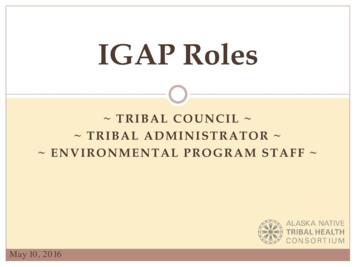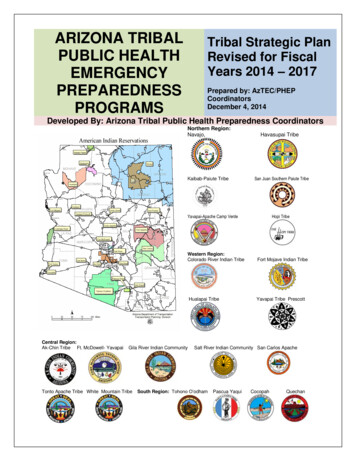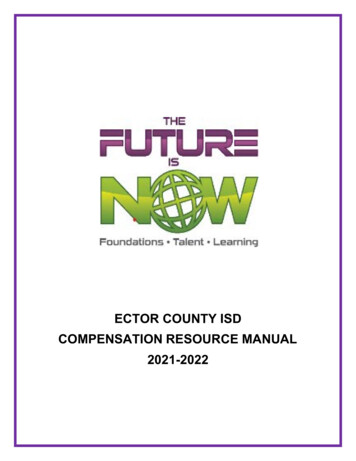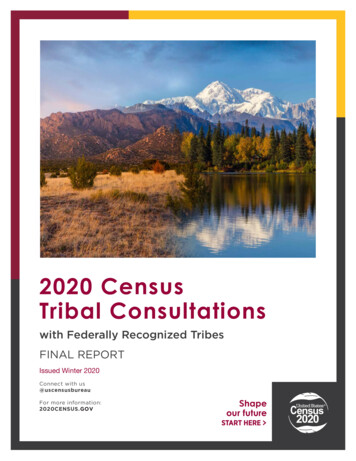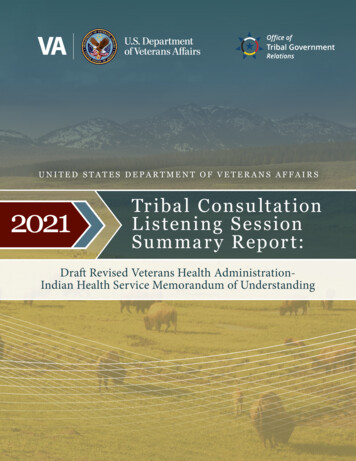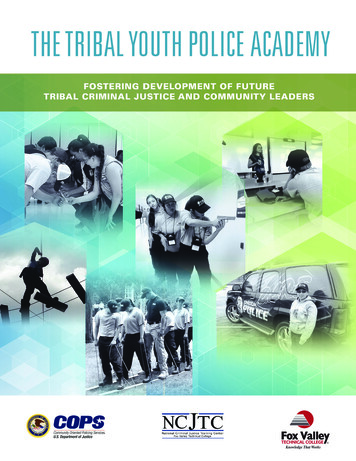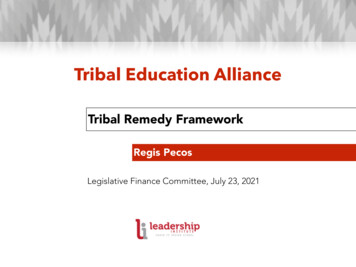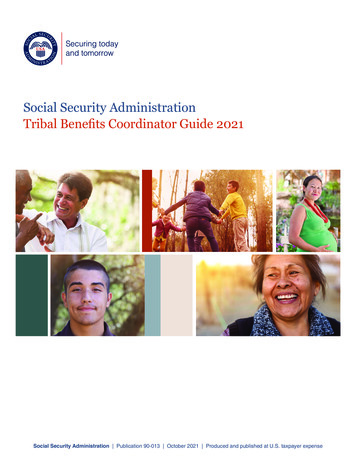
Transcription
Social Security AdministrationTribal Benefits Coordinator Guide 2021Social Security Administration Publication 90-013 October 2021 Produced and published at U.S. taxpayer expense
A Note to Benefit CoordinatorsWe appreciate the assistance you provide to Social Security beneficiaries and Supplemental SecurityIncome (SSI) recipients. We know sometimes it can be difficult to know when to contact us and who to talk toabout Social Security related issues. This Guide is designed to help find quick answers to common questions.Your feedback is important. Please contact your local Social Security office with questions and suggestions.DisclosureIn most other cases, clients must consent before Social Security will release information to them. If your clientis calling Social Security for information, they must be able to answer several identifying questions, even ifgiving oral permission for you to receive information. Your clients can also provide written consent on FormSSA-3288. Your clients can print the form online at www.ssa.gov/forms/ssa-3288.pdf. You may fax or maila signed SSA-3288 to your local Social Security Office.Disclosure is the release or showing of personal information about an individual to a third party — other thanthe person to whom it pertains or a minor child’s parent or legal guardian acting on the minor’s behalf. SocialSecurity’s privacy regulations allow us to disclose personal information to government agencies (such asTribal Government, Tribal Health Department, Indian Health Service, or Bureau of Indian Affairs) without anindividual’s consent when the information is needed to administer the agency’s own needs-based program.The agency must justify why they need the information for their program.1
Message from the Senior Advisor andTribal Consultation OfficialIt is my honor to continue in service as your Tribal liaison, bridgingSocial Security to sovereign tribal nations. As the Senior Advisor forthe Commissioner and Tribal Consultation Official, I am dedicatedto leveraging agency resources to serve tribal communities and tostrengthening our government-to-government relationships.This edition of the Tribal Benefits Coordinator Guide includes policyupdates and helpful information unique to Native Americans. It ismy hope that this guide will provide Tribal Benefits Coordinatorsan up-to-date picture of how Social Security serves IndianCountry communities.In August 2017, we appointed Renee Ferguson as the AmericanIndian and Alaska Native Executive Champion to support mycommitment to service delivery and outreach initiatives. Under Renee’sleadership, we continue to reinforce the need for building relationshipsin Native American communities — taking a more direct approach toimproving cultural awareness across Social Security.Thank you for your continued support as we continue, together,stepping in the right direction.Nancy A. BerryhillSenior Advisor to the Commissioner2
Message from the American Indianand Alaska Native Executive ChampionIt has been a pleasure to personally meet many of you as wecontinue our walk to meet the needs of tribal communities. The TribalBenefits Coordinator Guide is one way of providing the tools andresources specific to the communities we serve.I continue my commitment to provide accurate information to tribalcommunities to ensure timely communication on tribal issues. I seekto strengthen the voice of tribal leaders by enhancing outreach andcultural awareness opportunities.On behalf of the many people who worked to put the TribalBenefits Coordinator Guide together, I hope this will serve asa valuable resource when discussing Social Security benefits,services, and policies. If you have suggestions for improvementor questions about information in the guide, please reach out toyour local contacts or contact us through our dedicated mailbox atSSA.Tribal.Communications@ssa.gov.I look forward to collaborating with you. Thank you for yourcontinued support.Renee FergusonAIAN Executive Champion3
ContentsA Note to Benefit Coordinators. 1Windfall Elimination Provision. 23Disclosure. 1Disability Application Process. 23Message from the Senior Advisor(Former Acting Commissioner) and TribalConsultation Official. 2Filing Process. 23Disability Benefits for Children. 24Message from the American Indianand Alaska Native Executive Champion. 3Compassionate Allowances. 25Current Issues . 6Medicare Coverage for Disabled Individuals. 25Tribal Payment Exclusions for COVID-19Disaster Relief Funds. 6Continuing Disability Review (CDR). 25Tribal Social Security Fairness Act of 2018. 8Wounded Warriors. 27Contacting Social Security. 9Military Pay and Eligibility for Disability Benefits. 27my Social Security. 9Medicare and TRICARE. 27Apply Online at www.ssa.gov. 9Service Members Remain on Active Duty. 28Video Service Delivery. 10Supplemental Security Income (SSI). 29Social Security Office Locator. 11SSI Guidelines. 29The Social Security Card. 12SSI Income. 29Applying for an Original SSN. 12Resources. 30Canadian-born North American Indians. 12Institutions. 30Non-Citizen Applications. 12SSI for Children with Disabilities. 31Applying for a Replacement Card. 12SSI Child’s Income and Resources. 31Original Documents Needed. 13SSI Child’s Disability Requirements. 31Retirement. 15Providing Information about the Condition ofYour Client’s Child. 31Disability Evaluation. 24Child under Age 18. 26Calculating Retirement Benefits. 15The Decision Process. 32Work History Affects Retirement Benefits. 16We May Make Immediate SSI Payments toYour Client’s Child. 32Family Retirement Benefits. 16Spouses. 16SSI Continuing Disability Reviews (CDR). 32Unmarried Children and Grandchildren. 16When a Child Turns Age 18. 33Benefits for Divorced Spouses. 17SSI Continuing Eligibility Reviews(Redeterminations). 33Filing for Benefits. 17Required Documents. 18Unfavorable Determination. 34Timeline for Benefits. 18The Appeals Process. 35Survivors Benefits. 19Right to Appeal. 35Eligibility Requirements for Survivors Benefits. 19Four Levels of Appeal. 35Determining the Amount of Benefits. 20File an Appeal. 35Some Typical Situations. 20Reconsideration. 35Disability Benefits. 21Hearing by an Administrative Law Judge (ALJ).36Social Security Disability Programs. 21Appeals Council. 36Appointing a Representative. 21Federal District Court. 36Benefits for your Client’s Family. 224
Returning to Work. 37Medicare. 50Reporting Work Activity. 37Part A. 50Work Incentives. 37Part B. 50Receiving Payments. 39Part C. 50Direct Deposit. 39Part D. 50Direct Express. 39Medicare Enrollment. 51Direct Express Fees. 39Effective Date of Part A Enrollment. 51Report a Missing Payment. 40Effective Date of Part B Enrollment. 51Incorrect Payments. 40Medicare Savings Programs. 52Overpayments. 40General Enrollment for Part B. 52Repayment of Overpayments— Social Security Beneficiary. 41Special Enrollment Period. 52Enrollment in Part D – Medicare PrescriptionDrug Plan. 53Repayment of Overpayments— SSI Recipient. 41Extra Help (Subsidy) with MedicarePrescription Drug Plan. 53Overpayment Appeal Rights. 41Waiver Requests. 41Application Process. 53Underpayments for SSI Recipients with aDedicated Account. 41Online Resources. 55SSI Dedicated Accounts for ChildrenUnder Age 18. 42Plan Your Benefits. 55Conduct Business Online. 55SSI Installment Payments forRetroactive Benefits. 42Apply for Benefits. 56Representative and Organizational Payees. 43Questions and Answers. 58Representative Payees. 43Current Issues. 58Appointing a Representative Payee. 43General Questions. 60Representative Payee Responsibilities. 43Retirement Questions. 62Responsibilities of Reporting. 44Survivor Benefits Questions. 64Accounting Responsibilities. 44Disability Benefits Questions. 64When a Representative Payee StopsBeing a Payee. 45Supplemental Security Income Questions. 66When Your Client Wants to be TheirOwn Payee. 45Medicare Questions. 68For More Information. 56SSI AIAN Exclusions. 67Appeals Process Questions. 69Organizational Payees. 45Representative Payee Questions. 69Managing Benefit Payments. 46Incorrect Payment Questions. 70Training for Payees. 46Acronyms . 72Reporting Changes. 46Reporting Fraud, Waste, or Abuse. 47Reporting Elder Abuse. 47SSI Reporting. 48Tribal Courts. 49Resources:. 495
Current IssuesTribal Payment Exclusions for COVID-19 Disaster Relief FundsThe Coronavirus Aid, Relief, and Economic Security Act (CARES Act) signed into law on March 27, 2020provided for several types of disaster related assistance due to COVID-19. Later, both the ConsolidatedAppropriations Act, 2021 (CAA) signed into law on December 27, 2020 and the American Rescue Plan Actof 2021 (ARPA) signed into law on March 11, 2021 provided extensions and additional funding to several ofthese pandemic assistance programs. We recently updated our rules about what financial assistance canaffect your eligibility for SSI or your monthly SSI payment amount.Specifically, we no longer count the financial assistance listed below against your eligibility or paymentamount. We are reviewing claims going back to the beginning of the COVID-19 pandemic to updateour records. As a result, if you received one of these types of assistance, we may send you or yourRepresentative Payee a letter explaining the change we made, or information we need. You do not need todo anything. We will reach out to you or your Representative Payee by mail as we review your case.Effects of Covid-19-Related Financial AssistanceCountable Income and Resources forSSI PurposesCOVID-19 Disaster Related AssistanceCoronavirus Relief Fund for Tribal Governments, andCoronavirus State and Local Fiscal Recovery Funds.An emergency payment provided to tribal governmentsnavigating the impact of the COVID-19 outbreak. Thetribes are responsible for disbursing the funds to tribalmembers and using the funds to assist their tribalcommunity with obtaining the critical resources needed tocombat the virus.Excluded. Payments from Tribal governmentsto Tribal members that are funded by theCoronavirus Relief Fund established by theCARES Act, and Coronavirus State and LocalFiscal Recovery Funds, funded by the ARPA donot count as income and resources.Housing Assistance and Supportive ServicesPrograms for Native AmericansExcluded. Payments from Tribal governmentsto Tribal members for these programs that arefunded by the ARPA do not count as incomeand resources.Economic Impact Payments (EIP) also known asRecovery RebatesExcluded.Emergency stimulus payments to taxpayers and qualifyingchildren in the household under CARES, CAA, and ARPA.“Taxpayers” for this purpose also includes Social Securityand SSI beneficiaries who did not actually pay incometaxes. Some taxpayers may receive less than the amountsshown in the table due to adjusted gross income limits.LegislationAmount perTaxpayerAmount per eachqualifying childCARES 1,200 500CAA 600 600ARPA 1,400 1,4006
Countable Income and Resources forSSI PurposesCOVID-19 Disaster Related AssistanceUnemployment Compensation BenefitsEmergency unemployment benefits for qualifyingindividuals who are out of work because of theCOVID-19 pandemic.Excluded. SSA will exclude all regular andpandemic unemployment during a pandemicperiod from income and resources. Aspandemic-related programs end, we will resumenormal income-counting rules for unemployment.Higher Education Emergency Relief Fund (HEERF)Excluded.Emergency financial aid grants to students forexpenses related to the disruption of school operationsdue to COVID-19Paycheck Protection Program (PPP):Loan Forgiveness to Employers andSelf-Employed IndividualsExcluded. Excluded. However, any regularwage payments paid to employees that arefunded by this program are counted as earnedincome to the worker.Economic Injury Disaster Loan (EIDL) Program:Loans/Grants to Employers and Self-EmployedIndividuals /GrantsExcluded. Excluded. However, any regularwage payments paid to employees that arefunded by this program are counted as earnedincome to the worker.Coronavirus Food Assistance Program — DirectPayments to Farmers and RanchersExcluded.COVID-19 Veteran Rapid RetrainingAssistance ProgramExcluded.COVID-19 Funeral AssistanceExcluded.Emergency Rental Assistance FundExcluded.Emergency Assistance for Rural Housing/RuralRental AssistanceExcluded.Homeowner Assistance FundExcluded.Supporting Foster Youth and FamiliesExcluded.Emergency Assistance to Children and Familiesthrough the Pandemic Emergency Assistance FundExcluded.Farm Loan Assistance for Socially DisadvantagedFarmers and RanchersExcluded.USDA Assistance and Support for SociallyDisadvantaged Farmers, Ranchers, ForestLandowners and Operators, and GroupsExcluded.State Stimulus PaymentsSome exclusions may apply.7
Tribal Social Security Fairness Act of 2018Signed into law on September 20, 2018, the Tribal Social Security Fairness Act of 2018 amends the SocialSecurity Act by creating the Section 218 Agreement to allow voluntary Social Security coverage for federallyrecognized Indian Tribal council members. The coverage does not apply to general members of the tribe,just the council members. This legislation became effective upon the signing of the bill.The coverage is similar to that for state and local employees in that it is a voluntary request for coverageby a group. Tribal coverage does not have the same complexities of state and local coverage, commonlyreferred to as Section 218 coverage.Under this legislation, the Tribal Council is covered as a whole, not the individual tribal members. If the TribalCouncil has entered into agreement for coverage, that coverage will apply to any future council members. Asspecified in the legislation, the coverage cannot be terminated or altered once granted.The Tribe will need to complete the Tribal Council Member Coverage Template Agreement to requestcoverage. Tribal officials need to communicate directly with Social Security Administration regional specialiststo execute the agreements. Coverage will be effective the month after the month the agreement is signed byboth parties unless the Tribe requests a later effective date.The Tribal Council may also request retroactive coverage for periods for which they have already paidFICA taxes and not received a refund. The regional specialist will work with the tribe to provide instructionsfor this situation.The list of Regional Contacts is available at Social Security’s American Indians and Alaska Natives (AIAN)page under Tribal Security Fairness Act of 2018.8
Contacting Social Securitymy Social SecurityA personal my Social Security account provides ready access to information and allows the individual toconduct business with Social Security online. If your clients need proof of their Social Security, Medicare, orSupplemental Security Income (SSI) benefits, let them know they can get a benefit verification letter onlinewith a my Social Security account.You can serve your clients faster because they no longer have to travel to a Social Security office or waitfor a letter to be mailed to them. They can get up-to-date information they need online, perhaps even from acomputer in your office.With my Social Security, those who receive benefits can easily view, print, or save an official letter thatincludes proof of their benefit amount and type, as well as Medicare start date and withholding amount andage. Go to www.ssa.gov/myaccount.They can create an account if they are age 18 or older, have a Social Security number (SSN), a valid emailand U.S. mailing address. ID.me and Login.gov are other ways in which an individual can establish amy Social Security account.The client can go to www.ssa.gov/myaccount and input personal information to verify their identity. Then,choose a username and password to complete creating their account.Your client can use their my Social Security account to get a benefit verification letter, to check their earningsand work record, and in some states, request a replacement Social Security card. If they receive retirement,survivors, or disability benefits, they can also Change their address and phone number. Start or change their direct deposit. Request a replacement Medicare card. Print a replacement SSA-1099 or SSA-1042S for tax purposes. Report wages, if receiving Social Security Disability benefits.Apply Online at www.ssa.govYour clients can apply online for Social Security retirement, spouses’ benefits, Medicare, disability benefits,or Supplemental Security Income (SSI). The applicant must electronically sign their application and attest tothe accuracy of the information provided. After the application is complete, your clients have several ways tocheck the status of their application by Logging in to their my Social Security account Calling 1-800-772-1213 Monday through Friday 8 a.m. through 7 p.m. Call your local field officeWe also offer our online Benefit Eligibility Screening Tool (BEST) at www.benefits.gov to determine eligibilityfor benefits. Just by answering a series of questions, they can find out whether they are eligible for retirement,disability, or SSI benefits. You can even find out whether they might be eligible for Medicare benefits.9
Your clients can call us using our toll-free number 1-800-772-1213, Monday through Friday from 8 a.m.until 7 p.m. People who are hearing impaired may call our Text Telephone (TTY) number 1-800-325-0778.Automated services are available with a touch-tone phone. Services available include scheduling anappointment, address changes, and signing up for direct deposit of Social Security payments directlyto the bank.Video Service Deliverywww.ssa.gov/open/geospatial.htmlWe have Video Service Delivery (VSD) centers set up in some communities, so clients do not have to drive totheir local office.At a VSD center, a person can connect to a Social Security representative by using the video phone. TheSocial Security representative can see, talk to, and assist them in a way similar to a face-to-face meeting inan office. A client does not have to know how to use a computer for this service.VSD American Indians and Alaska Native (AIAN) Site MapVideo Service Delivery Site Map10
Social Security Office Locatorwww.ssa.gov/locatorMuch of the business with Social Security can be done online, but sometimes a person may want to talkwith a Social Security representative face-to-face. If that is the case, finding the nearest office is readilyavailable by visiting the online field office locator. You just type in your ZIP Code and find the nearestSocial Security office.11
The Social Security CardYour nine-digit Social Security number is your first and continuous connection with Social Security. It helpsus identify and accurately record your covered wages or self-employment earnings. We also use it to monitoryour record once you start getting benefits.A Social Security number is important because you need it to get a job, collect Social Security benefits andget some other government services. You should keep your Social Security card in a safe place with yourother important papers and avoid giving it out unnecessarily.Applying for an Original SSNAge 12 or Older ApplicationsAnyone age 12 or older who request an original Social Security number must appear in person for aninterview. You must present original documents or copies certified by the agency that issued them. We cannotaccept photocopies or notarized copies.NewbornsThe Enumeration at Birth authorization allows an individual to apply for a Social Security number for anewborn before leaving the hospital. The state agency will share the baby’s information with us, and the cardwill arrive in the mail. If the parent chooses to wait to apply for a Social Security number, and does not file atthe hospital, they must have the birth certificate and proper identification when applying at the local office.Canadian-born North American IndiansIndividuals born in Canada need a long-form birth certificate, a tribal ID (or other ID), and a blood quantumletter (BQL) to apply for a new SSN. If applying for a replacement Social Security card, these individuals canuse either a long- or short-form birth certificate, ID (tribal or other), and the BQL. If applying for a child, theaccompanying applicant must also submit ID.Non-Citizen ApplicationsIn general, only non-citizens who have permission to work from the Department of Homeland Security canapply for a Social Security number. A non-citizen application must prove immigration status as a studentor an individual with employment status or Lawful Permanent Resident. More information on non-citizenrequirements is available at www.ssa.gov/ssnumber/ss5doc.htm.Applying for a Replacement CardGet a replacement card in-personComplete an application for a Social Security Card (Form SS-5, available at www.ssa.gov/forms) andshow us original documents or certified copies (certified by the issuing agency) proving your U.S. citizenship,age, and identity.If applying on behalf of a child, proper identification is needed for parent and child.12
Request a Social Security Replacement Card OnlineYou can use a my Social Security account to apply for a replacement Social Security card online. You mustmeet the following requirements: Be a U.S. citizen age 18 or older with a U.S. mailing address (this includes APO, FPO,and DPO addresses); Are not requesting a name change or any other change to your card; and Have a driver’s license or state-issued identification card from one of the many participating states or theDistrict of Columbia.Note: In Delaware and Wisconsin, this service is available only if you have a driver’s license.If your driver’s license or state-issued identification card was issued by one of the states listed below,this service is not yet available. If your state appears on this list, please check back.We are working to make this service available to additional states. Alaska Minnesota New Hampshire Oklahoma West VirginiaThis service is also not yet available if your driver’s license or identification card was issued by a U.S. territory(such as American Samoa, Guam, Northern Mariana Islands, Puerto Rico, or the U.S. Virgin Islands).If you are a U.S. citizen, and have not gotten a replacement Social Security card or name change recently,you may not be eligible to use the online replacement card application in my Social Security.Visit www.ssa.gov/myaccount to find out this service is available in your area.Original Documents NeededCitizenship – We can only accept certain documents as proof of U.S. citizenship. These include a U.S.birth certificate or a U.S. passport. For individuals applying for a Social Security card for the first timewho were born outside the U.S. and are over the age of 12, they must show proof of long-term residencyoutside the U.S.If the client is not a U.S. citizen, they will need to submit other evidence proving their Native-American status.Age – If your client has or can obtain a U.S. state-issued birth certificate that recorded their birth before age5, they must submit it. If not, we can consider other documents, such as their passport, to prove their age.Identity – We can only accept certain documents as proof of identity. An acceptable document must becurrent (not expired) and show the name, identifying information (date of birth or age), and preferably, arecent photograph. For example, for proof of identity, Social Security must see the following documents: Current U.S. driver’s license Current state-issued non-driver identification card Current U.S. passport13
If your client does not have one of the documents listed above, or they cannot get a replacement documentwithin 10 days, we will ask to see other documents, such as Employee ID card School ID card Health insurance card (not a Medicare card) U.S. military ID card Tribal ID for which Social Security has established a precedent regarding its useAny of the identification documents listed must also include identifying information,like name, age, date of birth, and a photo.14
RetirementCalculating Retirement BenefitsMonthly retirement benefits are paid to workers who are at least age 62 and insured. A person becomesinsured by paying Social Security taxes. The taxes you pay earn credits toward benefits. Generally, a personneeds 40 work credits to be insured. For example, in 2021, a person earns one work credit for each 1,470in earnings. The amount needed to earn a work credit changes each year. A person can earn a maximum offour work credits per year. Someone earning 5,880 or more in 2021 would earn the maximum of four workcredits for the year. For more information about the amount of earnings it takes to earn a Social Securitycredit, please visit www.ssa.gov/OACT/COLA/QC.html#qcseries.Because retirement benefits are meant to replace part of the earnings a person had before they retired, anindividual who works over a set limit may have a reduction in the Social Security benefits they receive. Thelimit only applies if they are under Full Retirement Age (FRA) (See the following chart)Retirement ChartYear of BirthFull Retirement Age1937 or earlier65193865 and 2 months193965 and 4 months194065 and 6 months194165 and 8 months194265 and 1
Social Security to sovereign tribal nations. As the Senior Advisor for . the Commissioner and Tribal Consultation Official, I am dedicated . to leveraging agency resources to serve tribal communities and to strengthening our government-to-government relationships. This edition of the Tribal Benefits Coordinator Guide includes policy

